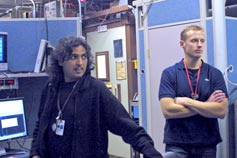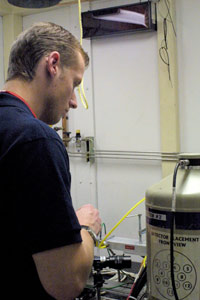
Handy Links
SLAC News Center
SLAC Today
- Subscribe
- Archives: Feb 2006-May 20, 2011
- Archives: May 23, 2011 and later
- Submit Feedback or Story Ideas
- About SLAC Today
SLAC News
Lab News
- Interactions
- Lightsources.org
- ILC NewsLine
- Int'l Science Grid This Week
- Fermilab Today
- Berkeley Lab News
- @brookhaven TODAY
- DOE Pulse
- CERN Courier
- DESY inForm
- US / LHC
SLAC Links
- Emergency
- Safety
- Policy Repository
- Site Entry Form

- Site Maps
- M & O Review
- Computing Status & Calendar
- SLAC Colloquium
- SLACspeak
- SLACspace
- SLAC Logo
- Café Menu
- Flea Market
- Web E-mail
- Marguerite Shuttle
- Discount Commuter Passes
-
Award Reporting Form
- SPIRES
- SciDoc
- Activity Groups
- Library
Stanford
Around the Bay
Getting Good Science: Four Days in the Life of an SSRL User
 Jason Holt has a very small problem on his hands. Holt, a researcher from Lawrence Livermore National Laboratory, has a batch of specially prepared carbon nanotubes, packed with hydrated ions of rubidium and bromine, and he wants to know something about how these ions behave confined inside the nanotubes. But these tiny, hollow pipes made of carbon, with walls only one atom thick, are far too small to see with ordinary microscopes.
Jason Holt has a very small problem on his hands. Holt, a researcher from Lawrence Livermore National Laboratory, has a batch of specially prepared carbon nanotubes, packed with hydrated ions of rubidium and bromine, and he wants to know something about how these ions behave confined inside the nanotubes. But these tiny, hollow pipes made of carbon, with walls only one atom thick, are far too small to see with ordinary microscopes.
Each year hundreds of scientists like Holt come to the Stanford Synchrotron Radiation Laboratory (SSRL) in search of answers in a variety of fields ranging from biology, to medicine, chemistry and environmental science, to name only a few. These investigators are what SSRL is all about. More than 50 laboratories around the world serve the scientific community with powerful experimental equipment that would otherwise be unavailable to individual researchers. Without access to these "lightsource" research facilities, many important scientific questions would go unanswered.
Holt's questions are more than just academic. Hydrated ions are charged atoms surrounded by a shell of water molecules, and they are found widely in nature. Hydrated ions of potassium, for instance, carry signals in the human nervous system. Nanotubes are similar in many ways to the channels that conduct ions in biological systems, and knowing how such ions behave inside nanotubes could aid in the design of new drugs or lead to new treatments for disease.
Last December, Holt had the chance to answer some of his questions. Collaborating with SSRL staff scientists Apurva Mehta, Sam Webb and others, and with the help of a beam of x-rays generated by SPEAR3, Holt's nanotubes began giving up some of their secrets.
"This is such a new field, no one really knows what to expect," Holt said.
A Hive of Activity
SSRL buzzes with a near constant hum of people and equipment. At first glance the scene looks not unlike a Hollywood depiction of the bridge of a starship. Most days, researchers cluster at work stations hidden in a maze of electronics and tall racks of experimental gear, with monitors flickering in every corner and experiments visible through leaded glass windows inside shielded x-ray hutches.
As with most users, Holt began preparations many months earlier, formulating his research agenda, applying for beamtime, preparing his samples. Now, before SSRL scientists and support staff turn the keys to the hutch over to him, the equipment is put through "check out." SSRL physicist Ronald Marks tests detectors, electronics and the optics that focus the beam to make sure things are things are set to specification for Holt's experiment. After a couple of hours Marks gives Holt the green light to start his work. "Happy hunting," he says.
Holt is articulate yet soft-spoken, sometimes nearly inaudible over the din of lab activity. Nanotubes, he explains, are unimaginably tiny—so tiny in fact, that the opening of most tubes in his sample is large enough to accept just a few atoms. In this experiment, Holt has prepared his samples mostly to contain hydrated ions of rubidium and bromine. To see what these ions are up to, packed in their "hydration sphere" of water inside the nanotubes, will require a powerful beam of x-rays, a series of special detectors, the unique expertise of the SSRL beamline scientists and many hours of steady patience.
"All our methods are based on sound theory," Holt says. "But we're working on a system that's almost a total unknown. We should be able to home in on the structure, but it's a real bear."

Apurva Mehta is an animated, enthusiastic researcher. One of Mehta's primary roles as
an SSRL beamline scientist is to make the sometimes temperamental adjustments required to produce the precise data users need.
The approach they have chosen for this run is a technique called x-ray
absorption and fluorescence spectroscopy (XAS).
XAS relies on a phenomenon wherein x-rays are absorbed by exciting the electrons within an element. The sample is placed between two sealed chambers, each shaped like a brick with slots in both ends, which are lined up end to end and filled with nitrogen. X-rays pass through the first chamber and interact with the nitrogen, Mehta explains, ionizing it and creating a measurable signal. The sample in the middle absorbs some of the x-ray energy before they pass into the next chamber, causing the gas in the second chamber to generate a different signal. The signal difference between the two chambers is plotted to give an x-ray absorption spectrum for a particular element. In this case, the x-rays are tuned to excite rubidium or bromine, and from the shape of the plot of the spectra the researchers can work out exactly how the ions and water molecules hold together inside the sample of nanotubes.
"This is a great technology because it only shows you what's around rubidium and bromine," Mehta says. "Basically we're looking at a needle in a haystack, but we're able to concentrate just on the needle."
In this kind of research, the periodic table of elements is like a pantheon of characters, each with its own special power or identity. By forcing an element into certain situations or relationships with other materials, the element becomes an experimental tool, much the same as the x-rays and detectors themselves. Studying rubidium in this case is not intended to tell us something new about rubidium. On the contrary, Holt chose rubidium because so much is already known about it. Rubidium's known properties are instead exploited to reveal something about nanotubes.
Getting to the Data
 Most of the first day of Holt's four-day run are devoted to trouble-shooting. Correctly configuring the equipment is a delicate process involving a degree of trial-and-error—opening the hutch, repositioning the sample, re-adjusting the detectors. At several points well into the evening, half a dozen other physicists crowd around an array of monitors at the beamline, watching blips from the detectors, scratching their heads when the numbers don't add up. Finally, after a few false starts and a cycle of adjustments, useable data starts trickling in. From now until the end of the run, Holt's experiments consist of running samples one at a time for up to 12 hours each over the weekend.
Most of the first day of Holt's four-day run are devoted to trouble-shooting. Correctly configuring the equipment is a delicate process involving a degree of trial-and-error—opening the hutch, repositioning the sample, re-adjusting the detectors. At several points well into the evening, half a dozen other physicists crowd around an array of monitors at the beamline, watching blips from the detectors, scratching their heads when the numbers don't add up. Finally, after a few false starts and a cycle of adjustments, useable data starts trickling in. From now until the end of the run, Holt's experiments consist of running samples one at a time for up to 12 hours each over the weekend.
Knowing what good data looks like is a bit like having to know the answer to a problem in order to solve the problem. The complexities associated with operating x-ray equipment efficiently make having a staff of beamline scientists as collaborators more than a little useful. Mehta and his colleagues are in this sense more than scientific collaborators. The beamline scientists' familiarity with the machinery enable them to more rapidly sift out noise from real data, helping researchers optimize the experimental set up as quickly as possible. That means users like Holt can get the most out of their limited beamtime.
Holt's initial results offered some interesting clues about how the chemistry of hydrated ions—especially bromine—changes when confined in nanotubes. For instance, earlier research indicated that the usual hydration sphere of bromine consists of just six water molecules surrounding the ion, and Holt's research confirmed this. But once confined inside nanotubes, he found, the hydration sphere becomes significantly more packed with water molecules without expanding much in size.
These experiments are part of a larger project Holt is leading at Lawrence Livermore National Laboratory to understand how both ions and water behave when squeezed down to the nanometer scale. The final trick, once Holt's data runs are complete, will be crunching these numbers, looking for new needles in the haystack. He says this will take a while.
"Recent models have shown that water behaves in a very unique manner when in the confines of a carbon nanotube," Holt says. "This is something of an experimental experiment. It's risky. We're not entirely sure if it will work. But if we can show promising results this time around, we can make a good case for longer beamtime in the future."
—Brad Plummer, February 14, 2007
Top image: Apurva Mehta and Jason Holt at SSRL Beamline 10-2.
Middle image: Apurva Mehta.
Lower image: Jason Holt
checks the alignment of the detector.